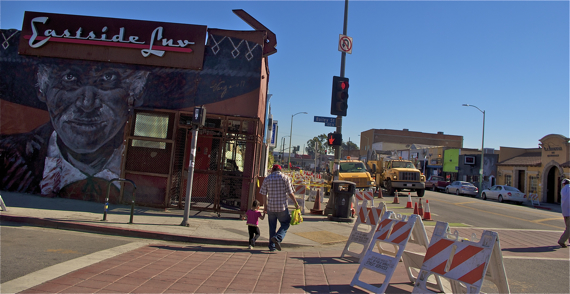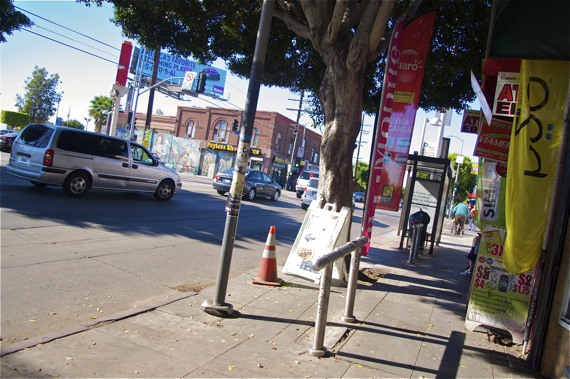
"Are you just visiting?" a woman asked as she watched me take pictures of a decrepit bench on Cesar Chavez.
I had to laugh -- I suppose I could have been mistaken for a misguided tourist taking photos of exotic oddities. It is not all that unusual to find out-of-towners lurking around Boyle Heights, cameras in hand, hoping to supplement their photos of historic murals with tidbits of local culture.
No, I explained, I was documenting some of the disconnect between the investment along 1st Street (as part of the Eastside Access project) and the neglect of some of the other important streets in the area.
"Oh!" she grabbed my hand. "I have a story for you."
She had been walking with her children along Marengo St., near LAC USC, when she came to an intersection where there was no curb ramp -- only a steep drop to the road. She had to look down at the road in order to navigate that drop with her son's stroller, she said, "and that's when my two girls were hit by a car."
I looked at her girls. They were so tiny -- maybe 5 and 7 years old.
"Were they hurt?" I asked.
They ended up being OK, she said, but it was maddening that poor infrastructure could make the streets that much more dangerous.
I nodded. That whole area around the hospital is really unpleasant to walk around, and I could see how it could make things very difficult for the community. Along Cesar Chavez alone, within just 15 minutes time, I had come across four people in wheelchairs, three elderly people with walkers, and numerous families with small children in strollers.
It wasn't just up that way, she continued. So many of the side streets were missing curb ramps that it was hard for families to get around their own neighborhoods.
"I hope you can write about that," she said. "That really needs to change."

The lack of investment in Boyle Heights' streets is troubling, considering how dependent so much of the community is on transit, biking, and/or walking.
Even on major streets that have curb ramps and other amenities, there is often much room for improvement, particularly with regard to the pedestrian environment.
The sidewalks of the commercial district along Cesar Chavez, for example, while alive with music and wonderful-smelling food, are actually pretty filthy, far more disrupted by ficus roots than much of 1st St. was, and cluttered with odd furniture.

In the heat of the day, these seating areas are of use to no one. And, as they don't function as bus stops, the fact that they face the street rather than the sidewalk can make them awkward to access, especially for people with strollers or wheelchairs or in areas where cars can park in front of them.
They make even less sense when the benches have been removed altogether and replaced with an ill-placed and poorly maintained trash receptacle.

Or, when they are joined by a planter, which is quite lovely, but equally neglected.

Other, more recent infrastructure can clutter up the sidewalk, too.
The lean bars placed at a few stops along the avenue by Metro were intended to help provide some infrastructure for bus riders at busy stops where, according to LADOT, there was not "the physical space to accommodate either a transit shelter or bus bench, or where the placement of a shelter or bench would have impeded the flow of pedestrians too much..."
But the bars' placement often appears obtrusive or redundant, especially in the case below, where you have two lean bars (one facing a pole), a shelter, lots of advertising from the shop on the sidewalk, and a woman (her feet are visible) who preferred to forego all that infrastructure and wait for the bus along the wall.

It's unfortunate that Cesar Chavez has been so overlooked; there seems to be little interest on the part of the city in creating a pleasant environment for those that do use that area.
Its commercial district, at least by my casual observation, supports a much greater pedestrian density than 1st St. It is also an important bus corridor, so there are always waves of people moving along it or sizable crowds gathered at popular stops.
Thanks to the random clutter and slabs of sidewalk pushed up by tree roots, it sometimes feels like there isn't enough space for everybody. Which is a shame, as one of the things I love about this area of Boyle Heights is the interaction with the musicians who gather at a few spots to socialize and the shop owners who often stand outside their shops, chit-chatting with patrons.

"Falta una sombrilla!" said a woman waiting for the bus with two friends. (We need shade!)
Please take a picture, said another woman in Spanish, gesturing at the bench. Let them know that this is how we must wait for the bus every day!
They had positioned themselves behind two poles next to the heavily-tagged bench, hoping to escape the noonday sun.
They were sweating profusely. The poles were clearly not helping.
I'll pass the word on, I said. I promise.







